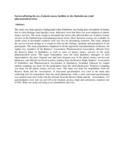Please use this identifier to cite or link to this item:
https://cris.library.msu.ac.zw//handle/11408/1794Full metadata record
| DC Field | Value | Language |
|---|---|---|
| dc.contributor.author | Nyakuyedzwa, Onias | - |
| dc.contributor.author | Mutanga, Marcus | - |
| dc.contributor.author | Siwadi, Patience | - |
| dc.date.accessioned | 2016-09-06T08:06:53Z | - |
| dc.date.available | 2016-09-06T08:06:53Z | - |
| dc.date.issued | 2014-12 | - |
| dc.identifier.issn | 2320-0294 | - |
| dc.identifier.uri | http://hdl.handle.net/11408/1794 | - |
| dc.description.abstract | The study was done against a background when Zimbabwe was facing poor circulation of money due to cash shortages and liquidity crisis. Indicators were that there was poor adoption of plastic money services. The study sought to document the factors that affected that use of plastic money services in the Zimbabwean retail pharmaceutical sector. Most literature sources are available on studies done in developed countries with very few on developing countries. The study adopted the survey research design as it sought to find out the feelings, opinions and perceptions of the participants. The study population comprised of all the registered retail pharmacies in Harare, the capital city, members of the Bankers’ Association, Pharmaceutical Association, officials from the Reserve Bank of Zimbabwe as well as users of plastic money services in the retail pharmaceutical sector. The target respondents were the retail pharmacy managers or their representative, the most frequent user and least frequent user of the plastic money services per pharmacy, and officials involved in policy making from the Reserve Bank, Bankers’ Association of Zimbabwe and Pharmaceutical Association of Zimbabwe. Stratified followed by simple random sampling was done for the participants from the retail pharmacies. Purposive sampling was done for the plastic money services users. The same was done for respondents from the Reserve Bank and the Associations. A structured questionnaire was used as the main data collection tool for respondents from the retail pharmacies while a semi structured questionnaire was used for interviews held with the officials from the Reserve Bank and the Associations. 153 questionnaires were sent out and 144 were returned, giving a high and satisfactory response rate of 94%. Data was analyzed using excel spreadsheets and was… | en_US |
| dc.language.iso | en | en_US |
| dc.relation.ispartofseries | International Journal of Engineering, Science and Mathematics;Vol. 3, No. 4; p. 1-16 | - |
| dc.subject | Plastic money, Zimbabwean retail pharmaceutical sector | en_US |
| dc.title | Factors affecting the use of plastic money facilities in the Zimbabwean retail pharmaceutical sector | en_US |
| dc.type | Article | en_US |
| item.openairetype | Article | - |
| item.openairecristype | http://purl.org/coar/resource_type/c_18cf | - |
| item.grantfulltext | open | - |
| item.cerifentitytype | Publications | - |
| item.fulltext | With Fulltext | - |
| item.languageiso639-1 | en | - |
| Appears in Collections: | Research Papers | |
Files in This Item:
| File | Description | Size | Format | |
|---|---|---|---|---|
| plastic money.pdf | Abstract | 12.61 kB | Adobe PDF |  View/Open |
Page view(s)
238
checked on Nov 30, 2025
Download(s)
74
checked on Nov 30, 2025
Google ScholarTM
Check
Items in MSUIR are protected by copyright, with all rights reserved, unless otherwise indicated.



